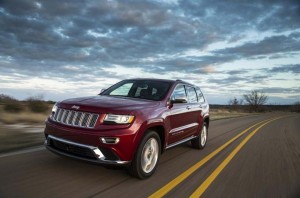
Jeep is struggling to meet surging demand for the flagship Grand Cherokee - the 2014 model shown here.
Chrysler is looking to kick up production of Jeep vehicles as it stretches to reach its objective of selling 800,000 Jeeps annually. More than half of those are to come from the SUV brand’s expanded plant in Toledo, Ohio.
The ramp-up of Jeep production is happening significantly faster than outlined in the playback Fiat/Chrysler CEO Sergio Marchionne unveiled in late 2009, shortly after the U.S. maker emerged from bankruptcy. But Jeep’s aggressive growth plans can’t soon enough for the Italian side of the company.
Marchionne told reporters in Italy earlier this week that a lack of Jeeps caused by the work at its factories – and a changeover to new models — will hurt the company’s finances during the first quarter. But he is hoping that the trans-Atlantic alliance can more than recover from that shortfall by year-end.
Chrysler’s Jefferson North plant in Detroit is still ramping up production of the new 2014 Jeep Grand Cherokee, which is also being prepared for expanded export as Marchionne pushes to transform Jeep into a truly global brand.
Toledo, where the Jeep Liberty was built is down now for a model changeover that will lead to the introduction of the brand new Jeep Cherokee, Chrysler officials have confirmed. The reborn Cherokee badge will replace the lackluster Liberty nameplate. Eventually, Jeep hopes to produce as many as 500,000 vehicles annually at the plant, an hour south of Detroit.
That will include production of the Jeep Wrangler, a perennial best seller. But, for the moment, Wranger production is hobbled by supply bottlenecks that up until now have prevented the addition of a third shift at the plant in Toledo. Chrysler has added third shifts at several other plants over the past year to meet the rising demand for its vehicles.
The slow sales of the Liberty have limited production at the newer Toledo North assembly line to one shift in recent months though Chrysler said last November it planned to spend $500 million to get the entire Toledo complex, which also includes spaces for suppliers, ready for the introduction of the Cherokee and the addition of a second production shift.
Mike Manley, president of the Jeep brand, said Chrysler would like to sell 800,000 Jeeps by 2014. Going global will be a critical part of that equation.
Jeep is working with a partner to build a new plant in China and is still negotiating to open a plant in Russia where the discussions have gone on for more than two years. In addition, Fiat’s Italian plants will add production of a new entry-level Jeep model later this year and South America also is ripe for expansion, so some company insiders believe sales of one million Jeep brand vehicles could come into reach over the next three to five years.
However, the heart of Jeep production remains the Detroit and Toledo plants where Chrysler is also eyeing additional investment beyond the $500 million already committed. No decision has been made, however, Manley told reporters as Chrysler rolled out six Jeep concept vehicles it has prepared for its annual Jeep Jamboree in Moab, Utah.
(Click Here to check out the six Jeep concepts, including the Trailhawk II, Flattop and Stitch.)
Chrysler is confident the new Cherokee, with its bold new design, will do better than the 90,000 Liberty sales posted last year. The new Cherokee is aimed directly at the largest piece of the SUV market, Manley said.
The automaker could wind up building as 220,000 Wranglers and we are going to do 250,000 Cherokees in Toledo, observers predicted.
Ironically, the success of the flagship Grand Cherokee forced Chrysler to scale back plans for the Detroit plant. It was originally hoping to also use the factory to assembly the new Levante, scheduled to be the first SUV for Fiat’s Maserati brand. With no room to maneuver it down the Jefferson North line, the Levante will now be built in Italy.
Further adding to Jeep’s potential growth – but also adding to its capacity challenges – the maker is considering other additions to its lines, most notably a full-size SUV that could replace the once-popular Grand Wagoneer – and challenge the likes of the Ford Expedition and Chevrolet Suburban. It’s unclear when a final go/no-go decision on that model will be made.
Paul A. Eisenstein contributed to this report.
